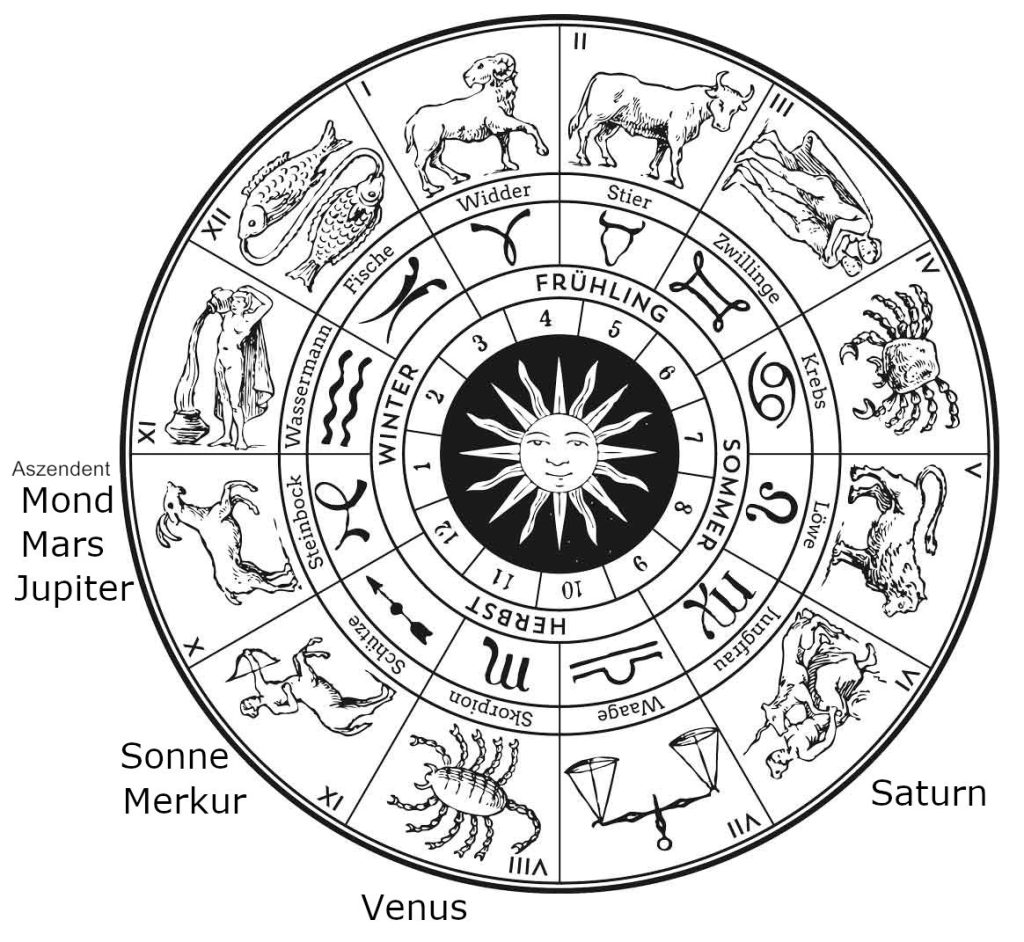(For the English version, see previous blog entry)
17. August 2023, Mathieu Ossendrijver und das ZODIAC-Team
In diesem Jahr feiert die Freie Universität Berlin ihren 75. Geburtstag. Das Forschungsprojekt „ZODIAC – Ancient Astral Science in Transformation“ hat dies als Anlass genommen, um die folgende Frage zu stellen: wie würde ein antiker Astrologe das Geburtshoroskop der Freien Universität Berlin bestimmen und ihre Zukunft deuten? Nicht nur die Antwort auf diese Frage ist interessant, auch die Beantwortung an sich liefert interessante Ergebnisse. Denn indem wir die einzelnen Schritte der Berechnung und der Deutung eines Horoskops nach antiken Verfahren rekonstruieren, werden mögliche Lücken in unserem Verständnis dieser Verfahren erkennbar.
Die horoskopische Astrologie entstand im 5. Jh. in Babylonien. Babylonische Gelehrte führten den Tierkreis mit zwölf Zeichen von 30 Grad ein und sie entwickelten eine neue astrologische Lehre, wonach die Zukunft eines Menschen aus den Tierkreispositionen von Mond, Sonne, und der fünf Planeten (Merkur, Venus, Mars, Jupiter und Saturn), die sie zur Zeit der Geburt einnahmen, abgeleitet werden kann. Die Zusammenstellung dieser Positionen wird als Horoskop bezeichnet. Neu an der horoskopischen Astrologie war auch, dass sie von Privatleuten benutzt wurde, und nicht nur von Herrschern, wie dies in der älteren mesopotamischen Astrologie der Fall war.
Die horoskopische Astrologie verbreitete sich von Babylonien aus nach Ägypten und in die griechisch-römische Welt, wo sie sich weiter entwickelte. In griechisch-römischen Horoskopen wird zusätzlich zu den Positionen von Mond, Sonne und Planeten auch der sogenannte Aszendent aufgezeichnet. Der Aszendent ist die Position im Tierkreis, entweder als ganzes Zeichen oder genauer bis zum Grad definiert, die zur Zeit der Geburt am östlichen Horizont aufgeht.
Die Positionen von Mond, Sonne, Planeten und Aszendenten wurden nicht beobachtet, sondern berechnet. Das ist schon daran erkennbar, dass an einem beliebigen Tag nicht alle Planeten sichtbar sind. Die Erstellung eines Horoskopes erforderte also umfangreiche mathematische Berechnungen. Um so erstaunlicher ist es, dass die horoskopische Astrologie sich so erfolgreich von Babylonian aus über die antike Welt verbreiten konnte.
Grundlage für die Erstellung eines Horoskops ist das Geburtsdatum. Als Geburtsdatum der Freien Universität Berlin nehmen wir das Gründungsdatum, 4. Dezember 1948. Da ein griechisch-römisches Horoskop zusätzlich den Aszendenten erwähnt, muss auch die Zeit der Gründung bekannt sein. Die genaue Zeit konnte leider nicht ermittelt werden. Wir haben 11:00 Mitteleuropäische Zeit als hypothetische Geburtszeit angenommen, weil wir dies als eine plausible Zeit für den Gründungsakt einschätzen.
Da es in der Antike unterschiedliche Verfahren gab um ein Horoskop zu berechnen und zu deuten, mussten wir daraus eine Selektion machen. Wir haben uns entschieden für eine babylonische Variante und eine griechisch-römische Variante.
Das Horoskop der Freien Universität Berlin nach modernen astronomischen Verfahren
Im Idealfall müssten alle Positionen nach antiken Verfahren berechnet werden. Da dies sehr aufwendig wäre, haben wir uns dafür entschieden, die Positionen zuerst mit Standardverfahren der modernen Astronomie zu berechnen. Das Ergebnis ist in der folgenden Tabelle zusammengestellt:
Horoskop für die FU Berlin, 4. Dezember 1948 11:00 MEZ
| Mond | 26º Steinbock |
| Sonne | 12º Schütze |
| Merkur | 8º Schütze |
| Venus | 10º Skorpion |
| Mars | 6º Steinbock |
| Jupiter | 4º Steinbock |
| Saturn | 6º Jungfrau |
| Aszendent | 26º Steinbock |
Die folgende Abbildung zeigt eine Visualisierung des Horoskops (mit Dank an Michael Zellmann-Rohrer):
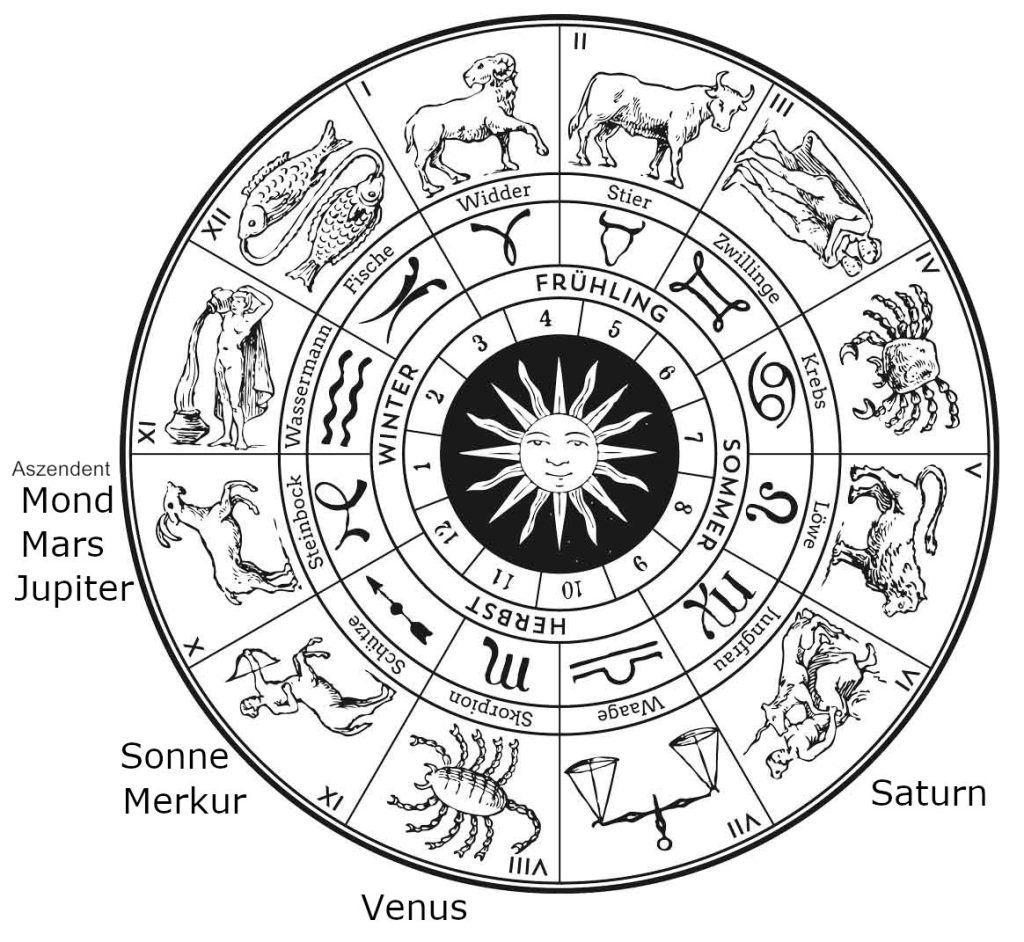
Berechnung des Horoskops nach babylonischen Verfahren am Beispiel von Jupiter
Wir zeigen jetzt zuerst, wie ein babylonischer Astrologe berechnet haben könnte, dass Jupiter sich am 4. Dezember 1948 in 4º Steinbock befand. Das wurde in zwei separaten Rechenschritten erreicht:
(1) Berechnung der synodischen Phänomene (Datum und Tierkreisposition). Die synodischen Phänomene Jupiters, die in Babylonien beobachtet und berechnet wurden, sind die Erste Sichtbarkeit, die Erste Station, der Aufgang am Abend, die Zweite Station, und die Letzte Sichtbarkeit. Sie bilden einen Zyklus, der etwa 13 Monate dauert (Fig. 1).
(2) Berechnung der Tierkreispositionen Jupiters von Tag zu Tag zwischen den synodischen Phänomenen.

Fig. 1 Scheinbare Bewegung Jupiters relativ zu den Sternen im Laufe eines synodischen Zyklus. Bis zur Ersten Station und nach der Zweiten Station bewegt sich Jupiter vorwärts (von rechts nach links); zwischen Erster und Zweiter Station rückwärts (von links nach rechts).
Schritt 1: Berechnung der synodischen Phänomene
Das letzte synodische Phänomen Jupiters, das sich vor dem 4. Dezember 1948 ereignete, war die Zweite Station. Wir berechnen darum, auf babylonische Art, zuerst eine Tabelle mit Zweiten Stationen, ausgehend von einer früheren Instanz dieses Phänomens. Die Babylonier rechneten in einem Zahlensystem das auf 60 basiert (sexagesimal). Zahlen werden als Sequenzen von Stellen 0–59 dargestellt, wobei jede Stelle zu einer nach rechts abnehmenden Potenz von 60 gehört. In Übersetzungen dient ein Komma als Trennzeichen zwischen den Stellen, mit einer Ausnahme: das Semikolon (;) trennt den Teil der Zahl grösser als 1 vom Teil kleiner als 1. Zum Beispiel 17;5,10 = 17 + 5/60 + 10/3600. Der babylonische Kalender der letzten Jahrhunderte v.u.Z. basiert auf der Seleukidenära, wobei Jahr 1 der Seleukidenära = 311/310 v.u.Z. Die babylonischen Monate werden als römische Ziffer abgekürzt. Der 4. Dezember 1948 entspricht dann Tag 2 von Monat IX des Jahres 2259 der Seleukidenära. Die Jahreszahl 2259 würde ein Babylonier als 37,39 schreiben (37 x 60 + 39 = 2259).
Als Anfangswerte für die Tabelle nehmen wir die Zweite Station Jupiters, die Tag 28, Monat VII, Jahr 37,29 (= 2249) der Seleukidenära in 26º Wassermann stattfand. Diese Werte hätte der babylonische Astrologe entweder einem Beobachtungsbericht oder einer existierenden Tabelle entnehmen können. Wir berechnen, ausgehend von der Zweiten Station im Jahr 2249, die darauffolgenden Instanzen der Zweiten Station mit einem babylonischen Algorithmus, der als „System A“ bekannt ist. Auf die Details des Algorithmus können wir hier nicht weiter eingehen. Wir beenden die Berechnung mit der Zweiten Station an Tag 10, Monat V des Jahres 2259 der Seleukidenära, was dem 16. August 1948 entspricht.
| Jahr der Seleukidenära | Monat | Tag | Tierkreisposition | |
| 37,29 (= 2249) | VII | 29 | 26º | Wassermann |
| 37,30 | VIII | 17;5,10 | 2º | Widder |
| 37,31 | X | 5;10,20 | 8º | Stier |
| 37,32 | X | 23;15,30 | 14º | Zwillinge |
| 37,33 | XII | 7;10,40 | 15;50º | Krebs |
| 37,34 | XII2 | 19;15,50 | 15;50º | Löwe |
| 37,36 | II | 1;21 | 15;50º | Jungfrau |
| 37,37 | III | 13;26,10 | 15;50º | Waage |
| 37,38 | III | 25;31,20 | 15;50º | Skorpion |
| 37,39 (= 2259) | V | 10;46,30 | 19º | Schütze |
Schritt 2: Berechnung der täglichen Position Jupiters seit dem letzten synodischen Phänomen
Im zweiten Schritt wird die Tierkreisposition Jupiters ab seiner Zweiten Station von Tag zu Tag bis zum Gründungstag der Freien Universität Berlin berechnet. Wir benutzen dafür eine babylonische Methode, wonach Jupiter sich mit konstanter Geschwindigkeit entlang der Ekliptik bewegt. Folgende Tabelle zeigt einen Ausschnitt aus der Berechnung:
| Jahr der Seleukidenära | Monat | Tag | Geschwindigkeit [º/Tag] | Position im Tierkreis | |
| 37,39 (= 2259) | V | 10 | 0;8,10 | 19º | Schütze |
| 37,39 | V | 11 | 0;8,10 | 19;8,10º | Schütze |
| 37,39 | V | 12 | 0;8,10 | 19;16,20º | Schütze |
| 37,39 | V | 13 | 0;8,10 | 19;24,30º | Schütze |
| und so weiter | |||||
| 37,39 | VIII | 29 | 0;8,10 | 3;50,10º | Steinbock |
| 37,39 | VIII | 30 | 0;8,10 | 3;58,20º | Steinbock |
| 37,39 | IX | 1 | 0;8,10 | 4;6,30º | Steinbock |
| 37,39 (= 2259) | IX | 2 | 0;8,10 | 4;14,40º | Steinbock |
Die Berechnung endet an Tag 2, Monat IX, Jahr 37,39 (= 2259) der Seleukidenära, was dem 4. Dezember 1948 entspricht, mit dem Ergebnis: Jupiter war in 4º Steinbock. Auf ähnliche Art und Weise hätte der babylonische Astrologe die Positionen von Mond, Sonne, und der anderen vier Planeten berechnet.
Das Horoskop der Freien Universität Berlin auf einer babylonischen Tontafel
Wie würde das Horoskop aussehen und welche Daten würde es enthalten? Die folgende Abbildung zeigt eine synthetische babylonische Tontafel mit dem Horoskop der Freien Universität Berlin, von Alessia Pilloni nach babylonischen Beispielen angefertigt und beschrieben.
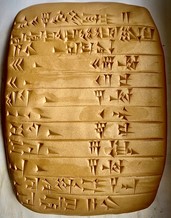
Hier folgt, für die Interessierten, die Transliteration der Tontafel:
MU.37.39.KAM ITI.GAN 2
E₂.DUB.BA ŠAR₂ URUBer-li-inKI
a-lid ina si-ma-ni-šu₂
sin ina 26 MAŠ₂
šamaš₂ ina 12 PA
MUL₂.BABBAR ina 4 MAŠ₂
dil-bat ina 10 GIR₂
GU₄.UD ina 7 PA
GENNA ina 6 ABSIN
AN ina 5 MAŠ₂
ina E₂ ni-ṣir-tu₄ ša₂ AN
E₂.DUB.BA a-lid
Und hier folgt die Übersetzung:
Jahr 2259, Monat IX, Tag 2,
die Universität zu Berlin
wurde geboren. Zu diesem Zeitpunkt war
der Mond in 27° Steinbock,
die Sonne in 12° Schütze,
Jupiter in 4° Steinbock,
Venus in 10° Skorpion,
Merkur in 7° Schütze,
Saturn in 6° Jungfrau,
Mars in 5° Steinbock.
Im Haus des Geheimnisses des Mars
wurde die Universität geboren.
Deutung des Horoskops nach babylonischen Verfahren
Wie würde ein babylonischer Astrologe das Horoskop deuten? Die Regeln, wonach die zukunft des Neugeborenen aus dem Horoskop abgeleitet wurde sind nur fragmentarisch bekannt. Ein Grund dafür ist, dass die Vorhersagungen nur selten auf dem Horoskop geschrieben wurden. Für bestimmte Konfigurationen von Planeten und Tierkreiszeichen, aber nicht für alle, die im Horoskop der FU auftreten, gibt es Sammeltafeln mit Vorhersageregeln. Es folgen einige Zitate aus solchen Tafeln, zusammengestellt von Marvin Schreiber. Die einzelnen Vorhersagungen sind zum Teil widersprüchlich. Wie ein babylonischer Astrologe daraus eine Gesamtdeutung des Horoskops ableiten würde ist nicht wirklich klar.
Mond, Mars, Jupiter in Steinbock
„Region des Steinbocks: er wird arm, erkranken, sterben“. Diese Regel aus einer Sammlung von Todesvorhersagungen verspricht nicht viel gutes, aber sie ist günstiger als die meisten anderen, wie z.B. „Region der Zwillinge: Tod im Gefängnis“.
Jupiter ist sichtbar, Mars unsichtbar
Das Horoskop erwähnt nicht, ob ein Planet sichtbar oder unsichtbar war. Babylonischen Astrologen konnten aber auch diesen Aspekt berücksichtigen. Am 4. Dezember 1948 war Jupiter nachts sichtbar, während Mars unsichtbar war, weil dieses Datum zwischen Letzter und Erster Sichtbarkeit ist.
„Wenn ein Kind geboren wird, Jupiter aufgeht und Mars untergeht: diesem Mann wird es gut gehen, er wird den Untergang seines Gegners erleben.“ Diese Regel verspricht gutes für die Freie Universität, schlechtes für ihren „Gegner“, der noch zu identifizieren wäre.
Mars in seinem Haus des Geheimnisses
Für jeden Planeten galt ein Tierkreiszeichen als „Haus des Geheimnisses“, ein Konzept, das etwa der „Erhöhung“ (Exaltation) in der griechisch-römischen Astrologie entspricht. Es ist anzunehmen, dass die Präsenz von Mars in seinem „Haus des Geheimnisses“ Steinbock die Wirkung dieses ungünstigen Planeten verstärkt, aber wie sich das auswirken könnte ist unbekannt.
Saturn, Mond, Jupiter und Mars im Trigon (Stier – Jungfrau – Steinbock)
Der Trigonalaspekt (Trigon = Dreieck von Tierkreiszeichen) spielte eine wichtige Rolle in der babylonischer Astrologie. Drei Planeten und der Mond befinden sich im Trigon Stier – Jungfrau – Steinbock. Entsprechende Vorhersagen sind nicht überliefert, aber wahrscheinlich wären diese günstig für das Neugeborene.
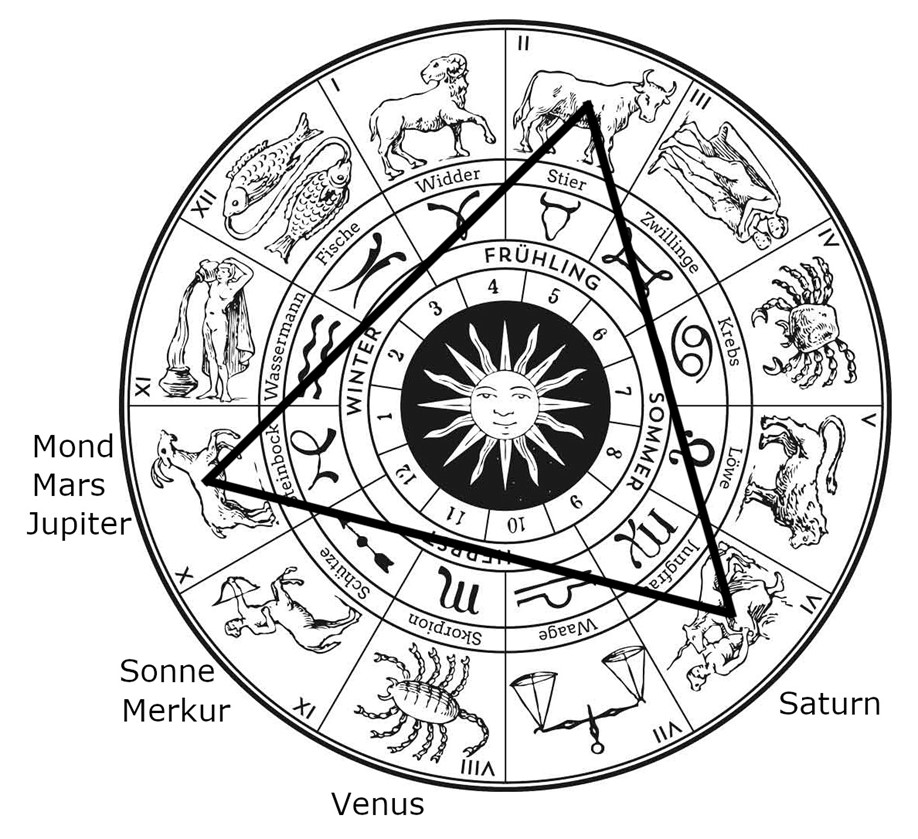
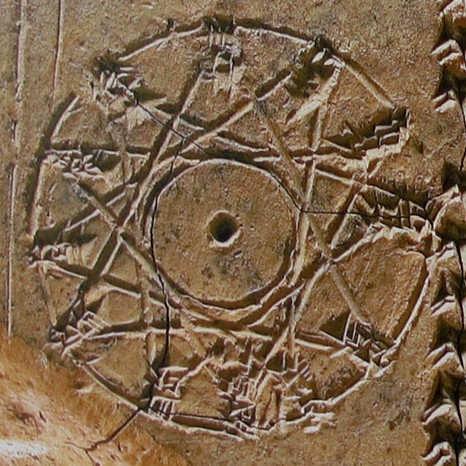
Deutung des Horoskops nach griechisch-römischen Verfahren
Die Regeln, wonach in der griechisch-römischen Welt ein Horoskop gedeutet wurde, sind vergleichsweise gut bekannt aus astrologischen Handbüchern, wie denjenigen von Vettius Valens (ca. 120–175 u.Z.), Firmicus Maternus (300–337 u.Z.), Hephaistion von Theben (5. Jh. u.Z). Die folgenden auf die Gründung der FU zutreffenden Regeln hat Michael Zellmann-Rohrer aus solchen Handbüchern entnommen:
Mars in seiner Erhöhung
Mars im Zeichen seiner Erhöhung, dem Steinbock: „Diplomatie angesichts schwieriger Umstände; Teilhabe an der Affinität des Mars zu feiner Kleidung und Wein.“
Konjunktionen
Jupiter, Mars, und Mond in Konjunktion: „kluge, mutige Staatsdiener mit vielen Freunden, die aus bescheidenen Anfängen zu großen Dingen aufsteigen, Vertrauen gewinnen und dann ihre Aufgaben übernehmen. Sie erleiden möglicherweise Verluste, erholen sich aber dank göttlicher oder unerwarteter Hilfe.“
Jupiter und Mars in Konjunktion: „Ehre wird nur durch harte Arbeit erlangt“
Jupiter und Mond in Konjunktion: „angesehene Ämter, Entdeckung von Schätzen“.
Sonne und Merkur in Konjunktion: „Flexibilität, Menschenverstand, Urteilsvermögen für Karriere im öffentlichen Leben, Liebe zur Schönheit, Wohltätigkeit, Einweihung in göttliche Lehren, Ausdauer von Widrigkeiten“
Saturn und Merkur im Quadrataspekt
Der Quadrataspekt betrifft Zeichen, die um 90 Grad voneinander getrennt sind. Er hat in der griechisch-römischen Astrologie im Allgemeinen einen negativen Charakter, in diesem Fall: „er wird mit Verwaltungspflichten und Angriffen von Neidern belastet sein.“
Aszendent in Steinbock
„Zuneigung zu Freunden, Klugheit, Glück, reichliche Ressourcen, Kenntnis der Geheimnisse heiliger Riten und fremder Lebensweisen.“
Die 12 Örter
Das Tierkreiszeichen des Aszendenten wurde als 1. Ort bezeichnet, in diesem Fall Steinbock. Von dort aus wurden die anderen 11 Ort gezählt. Damit verknüpft war eine Lehre mit eigenen Vorhersageregeln.
Mond, Mars, Jupiter im 1. Ort: „eine sehr glückliche Karriere, wohlverdiente Fortschritte vor Geschwistern, Ruhm, Tugend und gute Laune. Fortschritt durch brillante Kampagnen, Großzügigkeit, Erwerb von großem Eigentum, das später in Staatskasse übergeht.“
Merkur im 12. Ort: „Intelligenz“
Saturn im 9. Ort: „berühmte Zauberer, Wahrsager, Astrologen, berühmte Philosophen, die oft ihre Haare lang wachsen lassen, Traumdeuter.“
